Destined to Design
At 64, she made history as the oldest contestant ever on the show, which features up-and-coming designers, mostly in their 20s and 30s.
Yet Beringer herself was an up-and-coming designer.
Rewind just seven years, and you would find a 58-year-old Beringer behind a desk for her 18th year at the New Jersey Education Association.
It had been a good journey for a good mission. The association promotes excellence and equity in public schools and colleges across the state. Beringer helped drive that cause in many roles, from advocacy to program development, communications, and outreach.
She had recently married, gotten a much-sought-after promotion, and enjoyed a financially secure life. However, that coveted promotion landed her in an ill-fitting realm. Throughout her career, her roles had always had a creative component; now, she was managing people.
Her creative side was stifled. “I felt like my oxygen was being siphoned off when I was at work,” said Beringer. “I felt like I was suffocating.” It was time for a change.
That Aha Moment
Beringer remembers the exact moment she made the life-altering decision. “It was three in the morning, and I wasn’t sleeping again because I was not happy with my job.”
Inspired by her sons’ successes as young college grads following their dreams, she felt a twinge of envy and asked herself, “If I was young again, what would I want to learn?”
“It was a simple question, but that question changed my life. I had that aha moment. It was fashion design,” says Beringer.
She had learned to sew at age 12 and enjoyed vintage and thrift store shopping to create her own distinctive looks. But she had no other fashion experience, and her degree was in business education. So, this was a bold leap into new territory.
With encouragement from her husband and sons, Beringer left her education career at the top of her game and enrolled in a three-year Master of Science program in fashion design at Drexel University’s Westphal College of Media Arts & Design.
“I loved it,” says Beringer. “Once I got to Drexel, I felt like I found my home,” she says. “I felt like this is where I belonged, and most times, I forgot that I looked different than my classmates.” Beringer even came to see the humor in frequently being mistaken for the professor.
She was having the time of her life, but it wasn’t an easy path. The intensive program consumed 70 or 80 hours a week, often more. She had little time for anything else and was coping with the onset of painful arthritis. Ultimately, Beringer graduated at the top of her class, with a 4.0 grade point average and a record-setting seven awards at the 2016 Drexel Fashion Show.
And, while many of her classmates went to New York or Los Angeles to apprentice with other designers after graduation, Beringer didn’t have the luxury of time. She immediately started designing under her own label out of her Philadelphia studio.
Joan Shepp’s Window
For nearly 50 years, Joan Shepp in Philadelphia has been a premier fashion destination. The store is known for its collection of creative European, Japanese, and hard-to-find designers.
Beringer recalls that during her time at Drexel, it was always “‘You’ve got to see Joan Shepp’s new window.’ They are pieces of art.”
Recognized as one of the country’s style leaders by publications such as Harper’s Bazaar and Departures, the store welcomed fashion students and encouraged them to explore the collections. “It is just an iconic place; I thought of it as a research lab, and that’s where I would always go.”
Beringer’s first sale was at Joan Shepp. “I remember it well because the woman came out of the dressing room in the Dior-inspired skirt and just started twirling and got teary-eyed. She said, ‘I haven’t felt this beautiful in years.’ That’s when it really hit me how the power of fashion goes beyond the aesthetics; it goes into how you feel inside your heart and soul.”
I remember it well because the woman came out of the dressing room in the Dior-inspired skirt and just started twirling and got teary-eyed. She said, ‘I haven’t felt this beautiful in years.’ That’s when it really hit me how the power of fashion goes beyond the aesthetics; it goes into how you feel inside your heart and soul.
Nancy Beringer
Beringer started freelancing with Joan Shepp and designing those window displays, including one featuring her 2016 collection of evening wear. “This was in my first year out of fashion school. It was such an honor to be able to offer some of my work at her store.”
One garment in the Joan Shepp window would catapult Beringer’s new career to the next level.
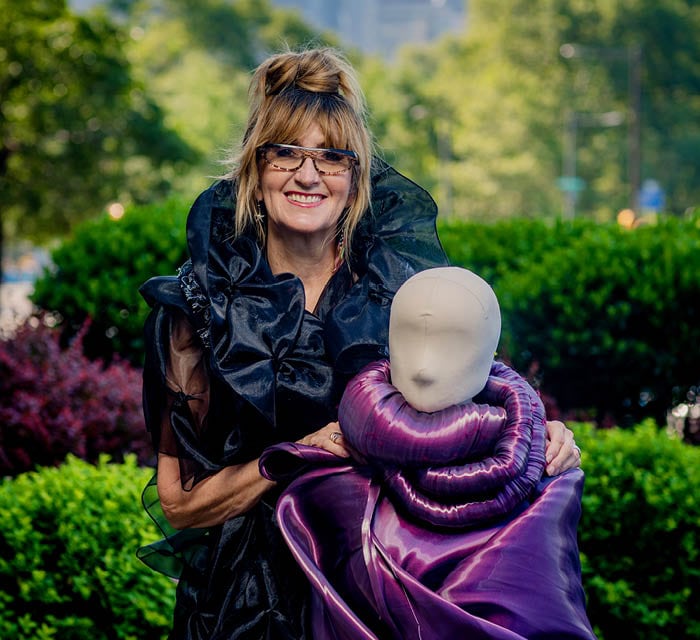
Beringer poses with one of her futuristic fluid designs
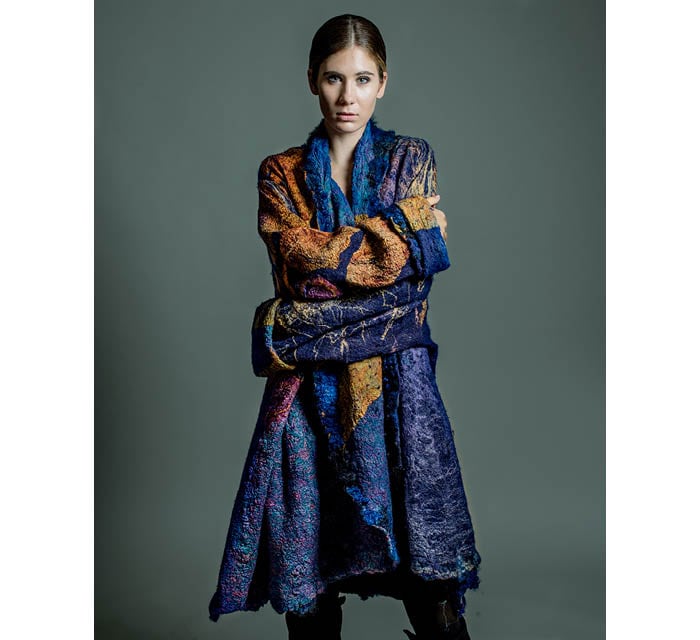
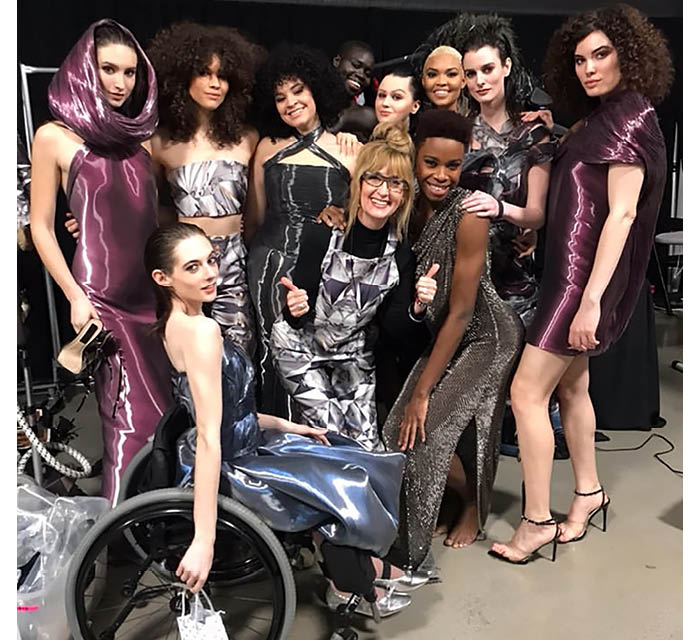
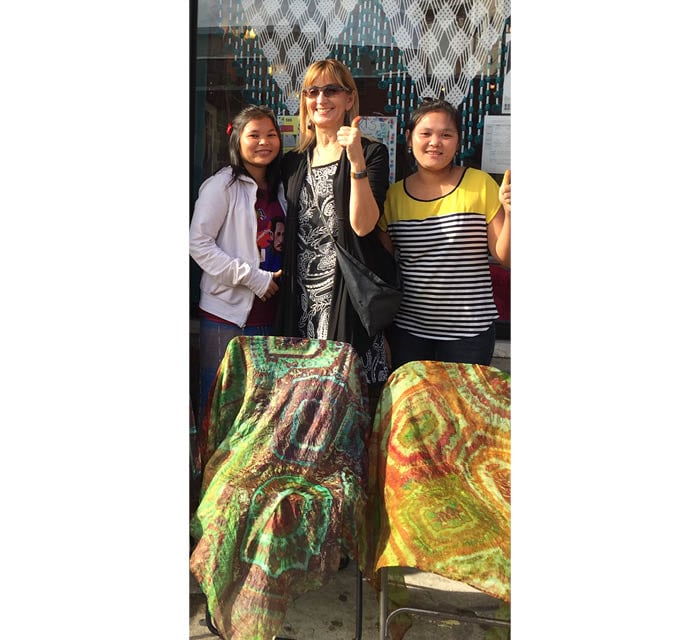
Beringer poses with her mentees from the Refugee Women’s Textile Initiative
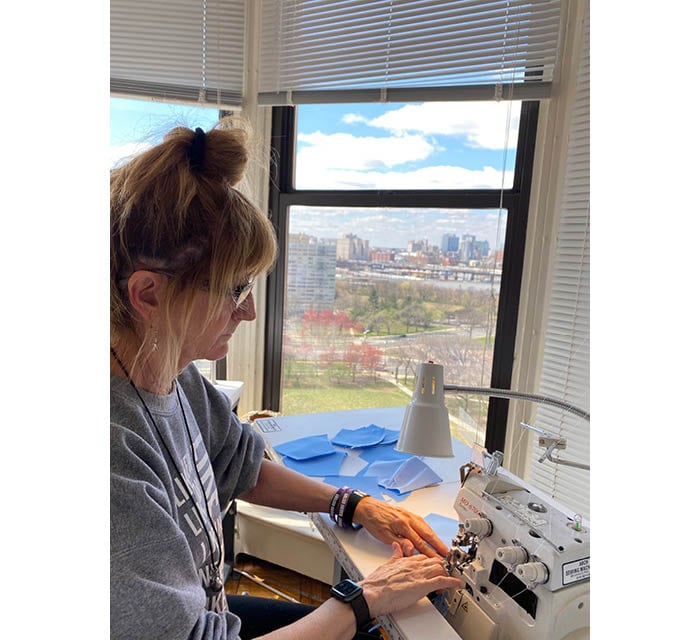
Mistake Gone Magic
Beringer was designing for a runway benefit based on a progressive dark-to-bright theme, symbolic of the emergence from substance abuse. A rainbow-colored swath of faux fur beckoned. A cape, perhaps? The organizers asked for something more dramatic—one of her sweeping, oversized Rosa coats.
“So, I designed this big coat,” says Beringer. “The funny thing is when I cut the first piece, I made a mistake. I cut it upside down.” Beringer goes on to explain.
“Picture your hair as we’re sitting here; it’s just flat. If I hold you upside down, [your hair would be] fighting gravity, and that’s what this faux fur did. So that mistake was the magic of the coat.”
After the charity show, the coat went into the window at Joan Shepp, where it was spotted by Philadelphia-based musical artist Tierra Whack. The 22-year-old star was looking for something to wear on the red carpet at the 61st Annual Grammy Awards. As soon as she saw the coat, she said, “That’s it.”
Beringer and Whack struck up a friendship on social media. “I wanted her to know the back story—that it represented empowering and helping women,” says Beringer.
Whack was enchanted by the coat. When she shared the news of her nomination for a Grammy for best music video, Beringer asked the artist to come to her studio in Philadelphia. When Whack stepped out of the car, “it was like a lightning bolt,” says Beringer, “a creative explosion. We had this instant connection.”
What followed was a whirlwind of preparations. One fitting, then another, and Whack leaves for Los Angeles before deciding on shoes. The coat will have to be hemmed on location.
In Los Angeles, Beringer finds herself at a private party with Whack’s entourage. “I look around the room and I realize I’m the oldest person in the room, designing for the coolest person in the room. Lucky me.” The coat and its wearer were a sensation on Grammy night.
“As a designer of evening wear,” says Beringer, “you fantasize of designing something for the red carpet, but what was important to me was that I had the trust of this genius artist in this big moment of her life.”
The next day’s New York Times featured three looks. The Technicolor Coat was one of them. Adding to the notoriety, E! named the ensemble one of the night’s most outrageous outfits. The coat earned Beringer a Best in Philly fashion design award.
As the Grammy event was going on, Beringer was invited to be a featured designer for Philly Fashion Week. A few months later, Philadelphia Magazine named her Best in Philly Fashion Designer for Artsy Dresses.
A Gift and an Opportunity
Beringer first saw Bravo’s Project Runway 10 years earlier. She harbored a secret, unspoken desire to be a contestant, vying to become the next great American designer. She didn’t even tell her Drexel classmates, thinking they might scorn reality television.
As a fresh Drexel graduate, she applied to be on the show. After making it to the second selection—the callback in New York—she was cut from the cast. But she didn’t take the rejection personally.
When I didn’t make it to the final stage, I viewed it as a gift and an opportunity, because I had affirmation from the judges and former contestants that my work was good enough to be on the show.
Nancy Beringer
“When I didn’t make it to the final stage, I viewed it as a gift and an opportunity, because I had affirmation from the judges and former contestants that my work was good enough to be on the show.”
Beringer viewed it as having another year to improve her craft. She took an intense online draping class out of Paris, a two-week patternmaking class in London, and couture classes.
In 2019, she made it onto the show. Sixteen designers showcased their talents in weekly challenges, with experiments directing them to use animal prints and thrift shop clothes, even taking a shot at designing the tuxedo of the future.
Beringer won the episode 11 challenge, which paired the designers with Olympic and Paralympic athletes to create a victory night celebration outfit. Beringer worked with Tatyana McFadden, a Russian-American athlete who has won 17 Paralympic medals in wheelchair track and field. Beringer wowed the judges with a silver ensemble: a feather bustier with fantasy skirt that doubles as a cape.
Week after week, Beringer kept up with the frenetic energy of the show and its time-constrained challenges, rising to the final four contestants by the last week. “That whole time, I felt it was my destiny,” she says.
Beringer’s on-air effervescence belied the personal physical challenges. “I’m 65 now, and I wake up in pain every day, but, because I’m active in designing, I feel better throughout the day,” she says.
Her Project Runway final collection featured futuristic, metallic, and fluid designs. A sculptural cut-out jumpsuit. A printed, tailored pantsuit. Shimmering dresses in liquid-look fabrics that danced in the runway lights.
The looks are eclectic, often androgynous and fantastical. “I don’t have a checkbox of ‘I design for this particular clientele or this look.’ It’s really a journey of exploration with my fabric, and I’m just delighted when it finds the right person to wear it, that it makes them feel empowered and gives them a sense of joy.”
Beringer finished as a runner-up and earned high praise from the judges, who admitted they had initially underestimated her. “I didn’t get the title. I didn’t get the money, which would have been really nice, but I did walk away as the winner because I left it all out there.”
Beringer chose the 10 models for her final collection to represent diversity and inclusion. “When we brought the models together for their first fitting, they looked around at each other, and they all got it,” says Beringer. “They saw that we were making a moment. They felt it.”
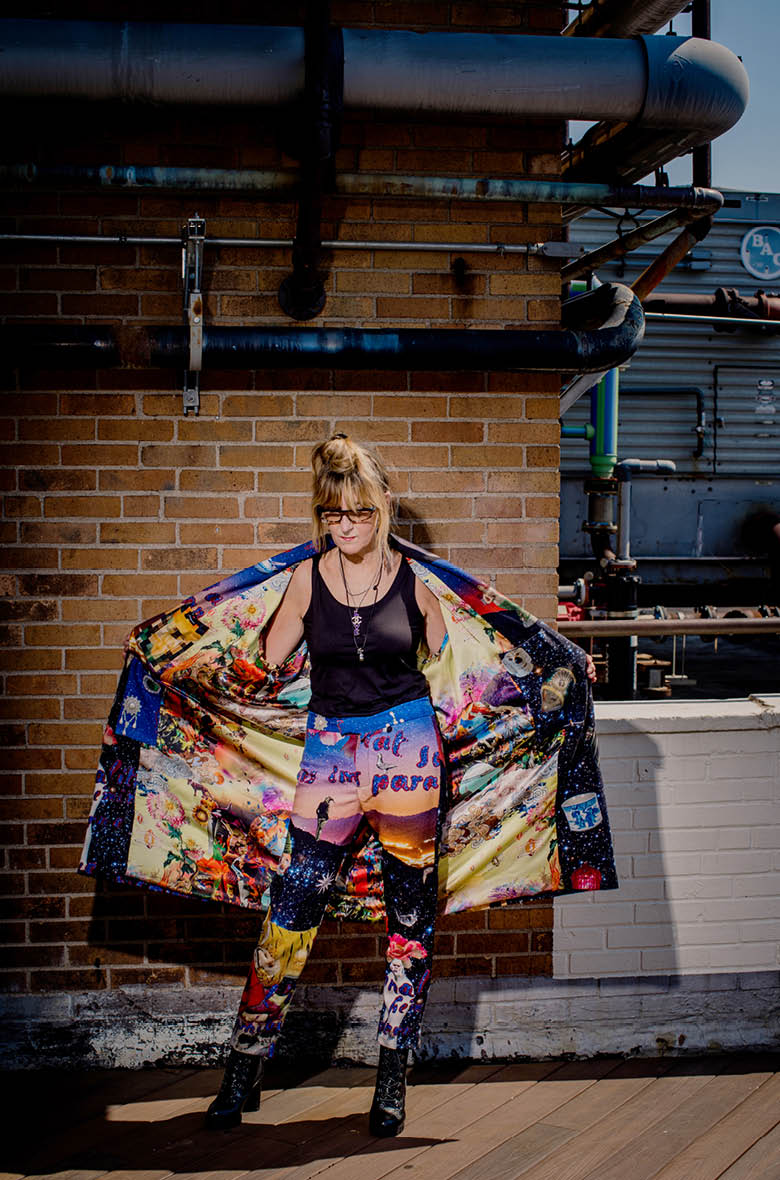
Dali Wearable Art Coat and Bottoms
This magical Wearable Art Coat is a tribute to Spanish surrealist painter Salvador Dali, displaying his most well-known pieces.
Fast-Forward to 2020
Life in pandemic days is quieter, with travel and shows on hold. The Joan Shepp store is temporarily closed. Beringer is self-quarantining in her studio, working 12 or more hours a day, seven days a week, on her craft. She avoids the news as much as possible.
When the world emerges from this forced pause, Beringer will be ready with unexpected new designs born out of the colorful chaos of her studio. She is where she is meant to be. “I found out fashion designing is not something I want to do; it’s something I need to do. It is pure oxygen for me.”
Alone in her studio, she will pick up fabrics, drape them over dress forms, transform them with novel techniques, and immerse herself in the joyous journey of letting the materials say what they want to be.
“I have this creative outlet. I can bring empowerment and joy to people, and I can also use my platform to give back and help make the world a little better. I just hope I am inspiring people to see that no matter what their challenge, age, or situation, it’s OK to hope, persevere, and pursue their dream.”
Four Keys to Following Your Dream
Feather Your Nest Egg. In making the career shift, Beringer was walking away from financial security. “But I could do it because of how financially conservative
I had been all along. I led a life that allowed me to follow this dream.” From her first job out of high school, making $100 a week, Beringer still set aside savings, then faithfully maxed out 401(k) contributions, invested, and minimized debt.
Rejoice in the Process. In today’s world, we are accustomed to instant gratification, information, and results, says Beringer. Everything is so immediate, right there. “It doesn’t always happen the first time or the second. My professional background easily translated into an understanding that design is a process.”
Be Fearless. Beringer is all about pushing the boundaries. “When working on a design or experimenting on a fabric, I’m like, ‘I’ll try it.’ What’s the worst that can happen? When you look at what’s happening in the world right now, whether or not it works or I need to start over, that’s not really significant.”
Don’t Wait for the Perfect Time. Had she waited until she was ready to be a red-carpet designer, that moment would have never arrived, says Beringer.
“I seem to be drawn to jobs I don’t know how to do,” she says with a laugh. “It’s OK to not know how to do something. Ask questions. Embrace the unknown. Embrace the learning and find your own joy.”